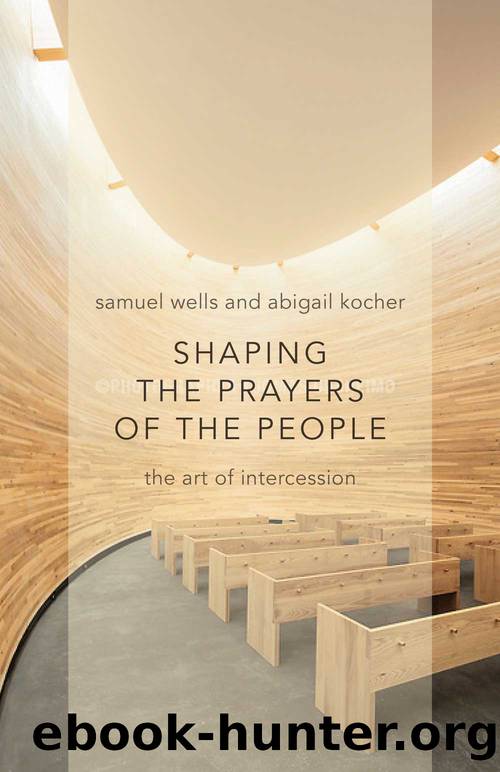Shaping the Prayers of the People by Wells Samuel;Kocher Abigail;

Author:Wells, Samuel;Kocher, Abigail;
Language: eng
Format: epub
Publisher: Wm. B. Eerdmans Publishing Co.
Published: 2014-05-07T00:00:00+00:00
Beauty
The prayers of the people shouldnât set out, in the first instance, to be a thing of beauty. They are a direct address to God, meant for one time and one place, and God is unlikely to be too concerned about the flavor of grammar or style. The important point is to be direct, honest, and succinct, and to express the prayer in such a way that everyone present can say âAmenâ at the end. Nonetheless, itâs appropriate to speak of a prayer being beautiful, if beauty names a deep resonance, a sense of completeness, a feeling of satisfaction, or an intimation of wholeness, for these are exactly the emotions an appropriate intercession should evoke. After the intercession there should be, in the congregation, a certain sense of relief, a freedom to exhale deeply in trust that something that very much needed to be done has been done. And there may well also be a half-Âshed tear, a sense that something has been named that is seldom named, a depth plumbed that is usually kept much more superficial, a burden shared that has been habitually carried alone. That is a moment of beauty.
When people refer to the beauty of a prayer, what they are often trying to name is the quality of being drawn deeply into a particular image, the experience of being absorbed in layer after layer of meaning. Itâs important to remember that less is more. People appreciate being given a particular focus rather than being asked to comprehend a wide range of concerns in a scattershot way. In many ways, prayer is training for learning to rest in the goodness of God. The fourteenth-Âcentury mystic Julian of Norwich, who was known for her wisdom on this subject, says, âRest in the goodness of God. For that goodness reaches to the depths of our needs.â The intercessor doesnât have to do a whole lot in prayer to keep God busy or to keep the congregation busy. It is important to be free of that notion. The sense that the prayer needs to be âbusyâ means it can end up containing too many images or mixed metaphors. It can mean that, in an effort to attain a prayerful mode, the person leading prayers piles up an overabundance of language, florid phrases, and garish verbosity, which, even if poetic, suffocate one another. A prayer that begins âGod of the glory of every corner of creation and every unfolding season, you woke us to fresh dew and green grass and refreshed us with rain even though it was a thunderstorm and warmed us with sun and fit us for glory like the blue eternal sky . . .â is already at risk of this overextension. The antidote to overdoing it is finding one or two images and going deep with them, discovering layers of meaning as you go. It might be better to say, âGod, who looked over your creation and called it good, give us the grace of rest to enjoy your world in the way you do.
Download
This site does not store any files on its server. We only index and link to content provided by other sites. Please contact the content providers to delete copyright contents if any and email us, we'll remove relevant links or contents immediately.
| Book of Common Prayer | Catechisms |
| Devotionals | Hymns & Hymnals |
| Meditations | Monasticism & Asceticism |
| Pentecostal & Charismatic | Prayerbooks |
| Rites & Ceremonies | Sacraments |
More Language of Letting Go: 366 New Daily Meditations by Melody Beattie(2849)
The Secret Power of Speaking God's Word by Joyce Meyer(2751)
To Light a Sacred Flame by Silver RavenWolf(2674)
How Proust Can Change Your Life by Alain De Botton(2613)
A TIME TO KEEP SILENCE by Patrick Leigh Fermor(1773)
Curse Tablets and Binding Spells from the Ancient World by Gager John G.;(1768)
Anxious for Nothing by Max Lucado(1721)
The Gnostic Gospel of St. Thomas by Tau Malachi(1677)
7 Secrets of Divine Mercy by Vinny Flynn(1616)
365 Tao: Daily Meditations by Ming-Dao Deng(1536)
From Good Goddess to Vestal Virgins: Sex and Category in Roman Religion by Ariadne Staples(1508)
all by Unknown Author(1495)
To Ride a Silver Broomstick by Silver RavenWolf(1476)
Anam Cara by John O'Donohue(1470)
The Fasting Edge by Jentezen Franklin(1453)
To Stir a Magick Cauldron by Silver RavenWolf(1426)
100 Days of Thanks by Thomas Nelson(1408)
The Sacred Enneagram by Christopher L. Heuertz(1376)
New Morning Mercies by Paul David Tripp(1323)
